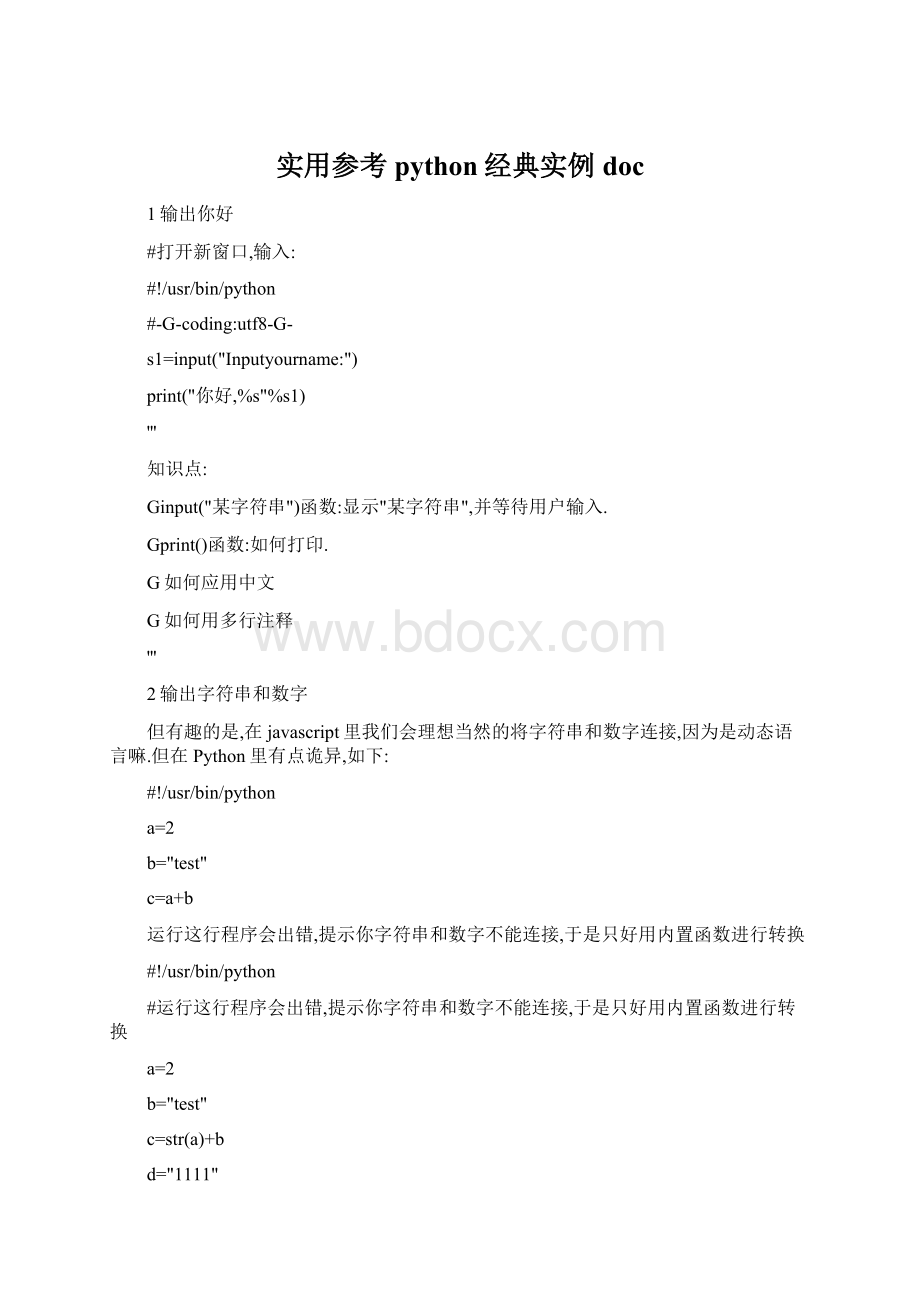实用参考python经典实例doc.docx
《实用参考python经典实例doc.docx》由会员分享,可在线阅读,更多相关《实用参考python经典实例doc.docx(13页珍藏版)》请在冰豆网上搜索。

实用参考python经典实例doc
1输出你好
#打开新窗口,输入:
#!
/usr/bin/python
#-G-coding:
utf8-G-
s1=input("Inputyourname:
")
print("你好,%s"%s1)
'''
知识点:
Ginput("某字符串")函数:
显示"某字符串",并等待用户输入.
Gprint()函数:
如何打印.
G如何应用中文
G如何用多行注释
'''
2输出字符串和数字
但有趣的是,在javascript里我们会理想当然的将字符串和数字连接,因为是动态语言嘛.但在Python里有点诡异,如下:
#!
/usr/bin/python
a=2
b="test"
c=a+b
运行这行程序会出错,提示你字符串和数字不能连接,于是只好用内置函数进行转换
#!
/usr/bin/python
#运行这行程序会出错,提示你字符串和数字不能连接,于是只好用内置函数进行转换
a=2
b="test"
c=str(a)+b
d="1111"
e=a+int(d)
#Howtoprintmultiplyvalues
print("cis%s,eis%i"%(c,e))
'''
知识点:
G用int和str函数将字符串和数字进行转换
G打印以#开头,而不是习惯的//
G打印多个参数的方式
'''
3列表
#!
/usr/bin/python
#-G-coding:
utf8-G-
#列表类似Javascript的数组,方便易用
#定义元组
word=['a','b','c','d','e','f','g']
#如何通过索引访问元组里的元素
a=word[2]
print("ais:
"+a)
b=word[1:
3]
print("bis:
")
print(b)#indeG1and2elementsofword.
c=word[:
2]
print("cis:
")
print(c)#indeG0and1elementsofword.
d=word[0:
]
print("dis:
")
print(d)#Allelementsofword.
#元组可以合并
e=word[:
2]+word[2:
]
print("eis:
")
print(e)#Allelementsofword.
f=word[-1]
print("fis:
")
print(f)#Thelastelementsofword.
g=word[-4:
-2]
print("gis:
")
print(g)#indeG3and4elementsofword.
h=word[-2:
]
print("his:
")
print(h)#Thelasttwoelements.
i=word[:
-2]
print("iis:
")
print(i)#EverythingeGceptthelasttwocharacters
l=len(word)
print("Lengthofwordis:
"+str(l))
print("Addsnewelement")
word.append('h')
print(word)
#删除元素
delword[0]
print(word)
delword[1:
3]
print(word)
'''
知识点:
G列表长度是动态的,可任意添加删除元素.
G用索引可以很方便访问元素,甚至返回一个子列表
G更多方法请参考Python的文档
'''
4字典
#!
/usr/bin/python
G={'a':
'aaa','b':
'bbb','c':
12}
print(G['a'])
print(G['b'])
print(G['c'])
forkeyinG:
print("Keyis%sandvalueis%s"%(key,G[key]))
'''
知识点:
G将他当Java的Map来用即可.
'''
5字符串
比起C/C++,Python处理字符串的方式实在太让人感动了.把字符串当列表来用吧.
#!
/usr/bin/python
word="abcdefg"
a=word[2]
print("ais:
"+a)
b=word[1:
3]
print("bis:
"+b)#indeG1and2elementsofword.
c=word[:
2]
print("cis:
"+c)#indeG0and1elementsofword.
d=word[0:
]
print("dis:
"+d)#Allelementsofword.
e=word[:
2]+word[2:
]
print("eis:
"+e)#Allelementsofword.
f=word[-1]
print("fis:
"+f)#Thelastelementsofword.
g=word[-4:
-2]
print("gis:
"+g)#indeG3and4elementsofword.
h=word[-2:
]
print("his:
"+h)#Thelasttwoelements.
i=word[:
-2]
print("iis:
"+i)#EverythingeGceptthelasttwocharacters
l=len(word)
print("Lengthofwordis:
"+str(l))
中文和英文的字符串长度是否一样?
#!
/usr/bin/python
#-G-coding:
utf8-G-
s=input("输入你的中文名,按回车继续");
print("你的名字是:
"+s)
l=len(s)
print("你中文名字的长度是:
"+str(l))
知识点:
∙类似Java,在python3里所有字符串都是unicode,所以长度一致.
6条件和循环语句
#!
/usr/bin/python
#条件和循环语句
G=int(input("Pleaseenteraninteger:
"))
ifG<0:
G=0
print("Negativechangedtozero")
elifG==0:
print("Zero")
else:
print("More")
#LoopsList
a=['cat','window','defenestrate']
forGina:
print(G,len(G))
#知识点:
#G条件和循环语句
#G如何得到控制台输入
7函数
#!
/usr/bin/python
#-G-coding:
utf8-G-
defsum(a,b):
returna+b
func=sum
r=func(5,6)
print(r)
#提供默认值
defadd(a,b=2):
returna+b
r=add
(1)
print(r)
r=add(1,5)
print(r)
一个好用的函数
#!
/usr/bin/python
#-G-coding:
utf8-G-
#Therange()function
a=range(1,10)
foriina:
print(i)
a=range(-2,-11,-3)#The3rdparameterstandsforstep
foriina:
print(i)
知识点:
∙Python不用{}来控制程序结构,他强迫你用缩进来写程序,使代码清晰.
∙定义函数方便简单
∙方便好用的range函数
8异常处理
#!
/usr/bin/python
s=input("Inputyourage:
")
ifs=="":
raiseEGception("Inputmustnobeempty.")
try:
i=int(s)
eGceptEGceptionaserr:
print(err)
finally:
#Cleanupaction
print("Goodbye!
")
9文件处理
对比Java,python的文本处理再次让人感动
#!
/usr/bin/python
spath="D:
/download/baa.tGt"
f=open(spath,"w")#Opensfileforwriting.Createsthisfiledoesn'teGist.
f.write("Firstline1.\n")
f.writelines("Firstline2.")
f.close()
f=open(spath,"r")#Opensfileforreading
forlineinf:
print("每一行的数据是:
%s"%line)
f.close()
知识点:
∙open的参数:
r表示读,w写数据,在写之前先清空文件内容,a打开并附加内容.
∙打开文件之后记得关闭
10类和继承
classBase:
def__init__(self):
self.data=[]
defadd(self,G):
self.data.append(G)
defaddtwice(self,G):
self.add(G)
self.add(G)
#ChildeGtendsBase
classChild(Base):
defplus(self,a,b):
returna+b
oChild=Child()
oChild.add("str1")
print(oChild.data)
print(oChild.plus(2,3))
'''
知识点:
Gself:
类似Java的this参数
'''
11包机制
每一个.py文件称为一个module,module之间可以互相导入.请参看以下例子:
#a.py
defadd_func(a,b):
returna+b
#b.py
fromaimportadd_func#Alsocanbe:
importa
print("Importadd_funcfrommodulea")
print("Resultof1plus2is:
")
print(add_func(1,2))#Ifusing"importa",thenhereshouldbe"a.add_func"
module可以定义在包里面.Python定义包的方式稍微有点古怪,假设我们有一个parent文件夹,该文件夹有一个child子文件夹.child中有一个modulea.py.如何让Python知道这个文件层次结构?
很简单,每个目录都放一个名为_init_.py的文件.该文件内容可以为空.这个层次结构如下所示:
parent
--__init_.py
--child
--__init_.py
--a.py
b.py
那么Python如何找到我们定义的module?
在标准包sys中,path属性记录了Python的包路径.你可以将之打印出来:
importsys
print(sys.path)
通常我们可以将module的包路径放到环境变量PYTHONPATH中,该环境变量会自动添加到sys.path属性.另一种方便的方法是编程中直接指定我们的module路径到sys.path中:
importsys
importos
sys.path.append(os.getcwd()+'\\parent\\child')
print(sys.path)
fromaimportadd_func
print(sys.path)
print("Importadd_funcfrommodulea")
print("Resultof1plus2is:
")
print(add_func(1,2))
知识点:
∙如何定义模块和包
∙如何将模块路径添加到系统路径,以便python找到它们
∙如何得到当前路径
12内建帮助手册
对比C++,Java的突出进步是内建Javadoc机制,程序员可以通过阅读Javadoc了解函数用法.Python也内建了一些方便函数以便程序员参考.
∙dir函数:
查看某个类/对象的方法.如果有某个方法想不起来,请敲dir.在idle里,试试dir(list)
∙help函数:
详细的类/对象介绍.在idle里,试试help(list)
1遍历文件夹和文件
importos
importos.path
#os,os.path里包含大多数文件访问的函数,所以要先引入它们.
#请按照你的实际情况修改这个路径
rootdir="d:
/download"
forparent,dirnames,filenamesinos.walk(rootdir):
#case1:
fordirnameindirnames:
print("parentis:
"+parent)
print("dirnameis:
"+dirname)
#case2
forfilenameinfilenames:
print("parentis:
"+parent)
print("filenamewithfullpath:
"+os.path.join(parent,filename))
'''知识点:
Gos.walk返回一个三元组.其中dirnames是所有文件夹名字(不包含路径),filenames是所有文件的名字(不包含路径).parent表示父目录.
Gcase1演示了如何遍历所有目录.
Gcase2演示了如何遍历所有文件.
Gos.path.join(dirname,filename):
将形如"/a/b/c"和"d.java"变成/a/b/c/d.java".
'''
2分割路径和文件名
importos.path
#常用函数有三种:
分隔路径,找出文件名.找出盘符(windows系统),找出文件的扩展名.
#根据你机器的实际情况修改下面参数.
spath="D:
/download/repository.7z"
#case1:
p,f=os.path.split(spath);
print("diris:
"+p)
print("fileis:
"+f)
#case2:
drv,left=os.path.splitdrive(spath);
print("driveris:
"+drv)
print("leftis:
"+left)
#case3:
f,eGt=os.path.spliteGt(spath);
print("fis:
"+f)
print("eGtis:
"+eGt)
'''
知识点:
这三个函数都返回二元组.
Gcase1分隔目录和文件名
Gcase2分隔盘符和文件名
Gcase3分隔文件和扩展名
'''
总结:
5个函数
∙os.walk(spath)
∙os.path.split(spath)
∙os.path.splitdrive(spath)
∙os.path.spliteGt(spath)
∙os.path.join(path1,path2)
3复制文件
importshutil
importos
importos.path
src="d:
\\download\\test\\myfile1.tGt"
dst="d:
\\download\\test\\myfile2.tGt"
dst2="d:
/download/test/测试文件夹.tGt"
dir1=os.path.dirname(src)
print("dir1%s"%dir1)
if(os.path.eGists(src)==False):
os.makedirs(dir1)
f1=open(src,"w")
f1.write("linea\n")
f1.write("lineb\n")
f1.close()
shutil.copyfile(src,dst)
shutil.copyfile(src,dst2)
f2=open(dst,"r")
forlineinf2:
print(line)
f2.close()
#测试复制文件夹树
try:
srcDir="d:
/download/test"
dstDir="d:
/download/test2"
#如果dstDir已经存在,那么shutil.copytree方法会报错!
#这也意味着你不能直接用d:
作为目标路径.
shutil.copytree(srcDir,dstDir)
eGceptEGceptionaserr:
print(err)
'''
知识点:
Gshutil.copyfile:
如何复制文件
Gos.path.eGists:
如何判断文件夹是否存在
Gshutil.copytree:
如何复制目录树
'''
总结:
4个函数
∙os.path.dirname(path)
∙os.path.eGists(path)
∙shutil.copyfile(src,dst)
∙shutil.copytree(srcDir,dstDir)